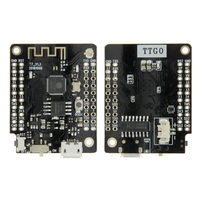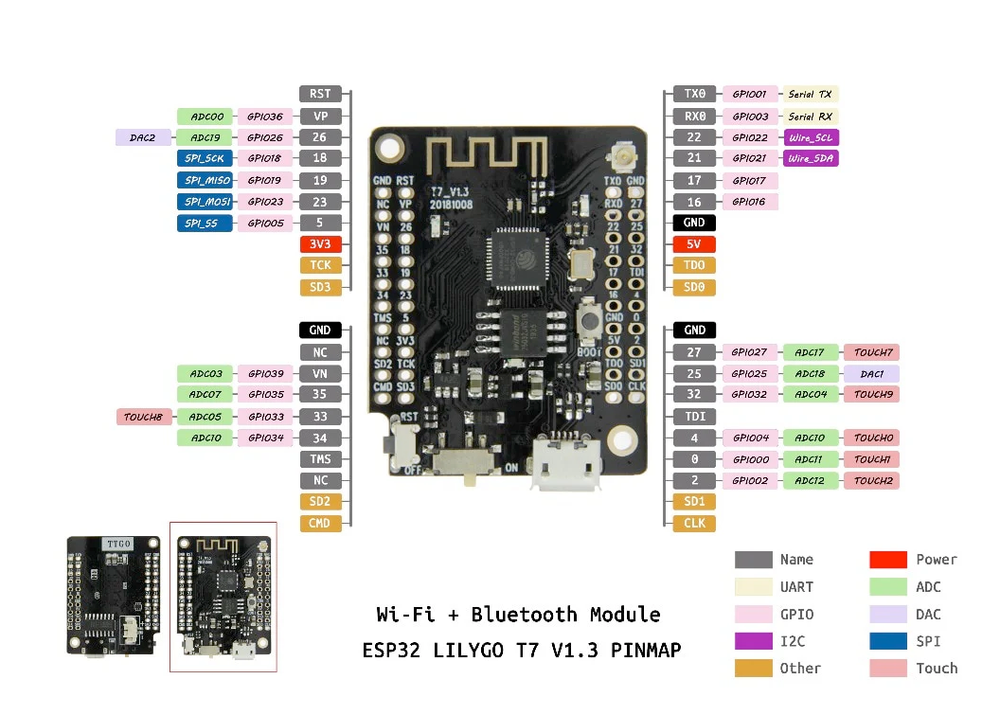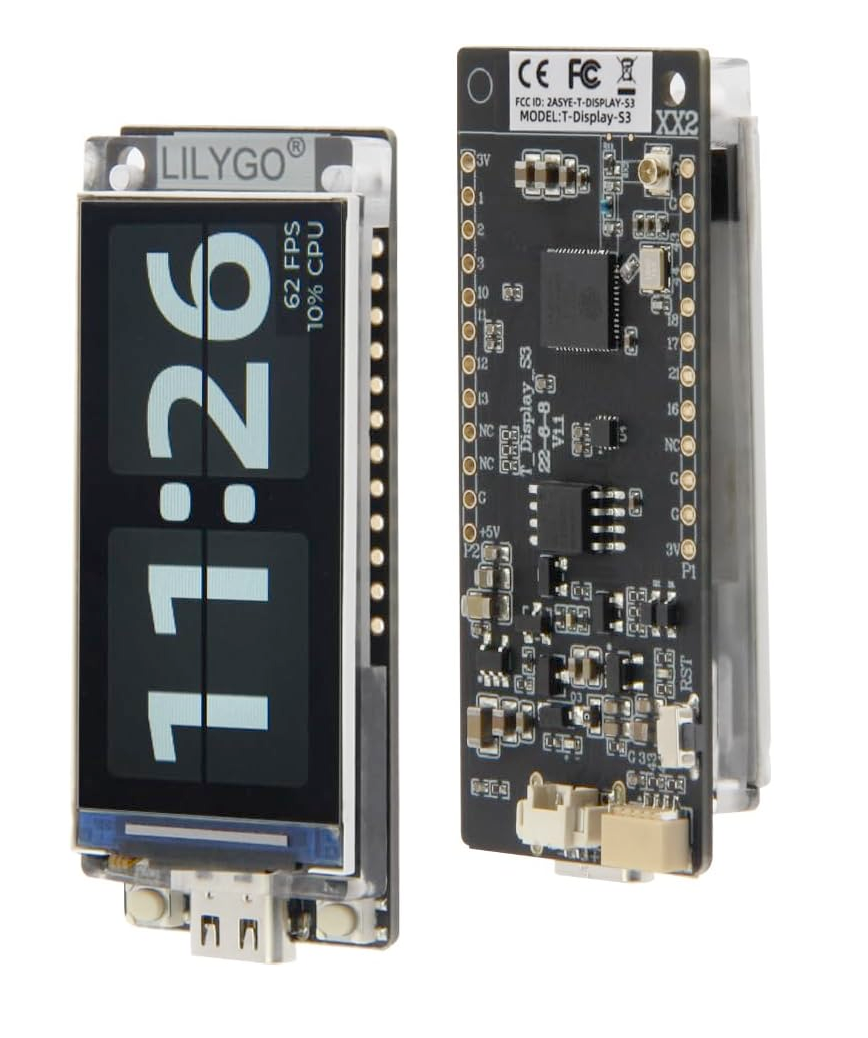TTGO T7 V1.3 Mini32 Development Board
Code name: TTGO_T7_V13_Mini32
TTGO T7 V1.3 Mini32 development board is based on esp32 microcontroller and uses xtensa architecture. This board has a maximum CPU frequency of 240 MHz and a flash size of 4MB.
About TTGO T7 V1.3 Mini32
Compact ESP32 dev board with auto-reset and USB — ideal for space-saving Wi-Fi/BLE applications.
Technical Specifications
🛰️ Connectivity
🧠 Microcontroller
✨ Features
- 40 digital IO pins
- 16 external interrupt pins
- 16 analog input pins
- 19 PWM pins
TTGO T7 V1.3 Mini32 Pinout
✅ Safe Pins to Use
For general GPIO usage, these are the safest and most flexible choices:
Why Are These Pins Safe?
- Not involved in bootstrapping → No impact on device boot mode or system startup
- Not linked to flash memory or PSRAM → Won't interfere with storage or memory access
- Not dedicated to USB or JTAG → Free for general use without affecting debugging
- No special hardware connections → Freely assignable without internal conflicts
⚠️ Pins to Avoid or Use with Caution
Some pins are reserved for critical functions like bootstrapping, JTAG debugging, USB communication, and flash memory operations. Misusing these pins may lead to boot failures, programming issues, USB conflicts, or disruptions in flash storage.
Critical Pin Categories:
- 🛠️ Strapping Pins: Control boot behavior and flash voltage selection
- 🔗 JTAG Debugging Pins: Required for low-level debugging
- 🔌 USB Communication Pins: Used for USB Serial/JTAG communication
- ⚡ Flash Memory & SPI Pins: Connected to SPI flash memory and PSRAM
- 📡 UART Serial Communication Pins: Used for debugging and firmware uploads
| PIN | Label | Reason | Function |
|---|
TTGO T7 V1.3 Mini32 Useful Links
TTGO T7 V1.3 Mini32 Pin Mappings
This development board provides 40 digital IO pins, out of which 16 can be used as external interrupt pins , 16 as analog input pins and 19 pins have Pulse-Width Modulation (PWM) .
| Pin | Function | ESP Pin | Input/Output | Description |
|---|---|---|---|---|
| 1 | OLED RST | GPIO16 | output | OLED Reset |
| 2 | OLED SDA | GPIO21 | bidirectional | I2C Data Line for OLED |
| 3 | OLED SCL | GPIO22 | bidirectional | I2C Clock Line for OLED |
| 4 | SDCard CS | GPIO5 | output | SPI Chip Select for SD Card |
| 5 | SDCard MOSI | GPIO23 | bidirectional | SPI Master Out Slave In for SD Card |
| 6 | SDCard MISO | GPIO19 | bidirectional | SPI Master In Slave Out for SD Card |
| 7 | SDCard SCLK | GPIO18 | bidirectional | SPI Clock Line for SD Card |
| 8 | LORA MOSI | GPIO27 | bidirectional | SPI Master Out Slave In for LoRa |
| 9 | LORA MISO | GPIO19 | bidirectional | SPI Master In Slave Out for LoRa |
| 10 | LORA SCLK | GPIO5 | bidirectional | SPI Clock Line for LoRa |
| 11 | LORA CS | GPIO18 | output | SPI Chip Select for LoRa |
| 12 | LORA RST | GPIO14 | output | LoRa Reset |
| 13 | LORA DIO0 | GPIO26 | input | LoRa Interrupt Pin |
| 14 | DS3231 SDA | GPIO21 | bidirectional | I2C Data Line for DS3231 RTC |
| 15 | DS3231 SCL | GPIO22 | bidirectional | I2C Clock Line for DS3231 RTC |
| 16 | LED_BUILTIN | GPIO2 | output | Built-in LED |
| 17 | ADC1_CH0 | GPIO36 | input | Analog Input Channel 0 |
| 18 | DAC1 | GPIO25 | output | Digital-to-Analog Converter 1 |
| 19 | DAC2 | GPIO26 | output | Digital-to-Analog Converter 2 |
TTGO T7 V1.3 Mini32 Pins Mapping Arduino IDE
Below you can find the TTGO T7 V1.3 Mini32 pinout. This development board provides 40 digital IO pins, out of which 16 can be used as external interrupt pins, 16 as analog input pins and 19 pins have Pulse-Width Modulation (PWM).
| Pin | Analog | Touch | PWM | Other |
|---|---|---|---|---|
| 0 | A11 | T1 | ||
| 1 | PWM | TX | ||
| 2 | A12 | T2 | PWM | |
| 3 | PWM | RX | ||
| 4 | A10 | T0 | PWM | |
| 5 | PWM | SS | ||
| 12 | A15 | T5 | PWM | |
| 13 | A14 | T4 | PWM | |
| 14 | A16 | T6 | PWM | |
| 15 | A13 | T3 | PWM | |
| 18 | PWM | SCK | ||
| 19 | PWM | MISO | ||
| 21 | PWM | SDA | ||
| 22 | PWM | LED_BUILTIN SCL | ||
| 23 | PWM | MOSI | ||
| 25 | A18 | PWM | DAC1 | |
| 26 | A19 | PWM | DAC2 | |
| 27 | A17 | T7 | PWM | |
| 32 | A4 | T9 | PWM | |
| 33 | A5 | T8 | PWM | |
| 34 | A6 | |||
| 35 | A7 | |||
| 36 | A0 | |||
| 39 | A3 |
Default Tools
| Bootloader tool | esptool_py |
| Uploader tool | esptool_py |
| Network uploader tool | esp_ota |
| Bootloader address | 0x1000 |
| Flash mode | dio |
| Boot mode | dio |
| Maximum upload size | 1280 Kb (1310720 B) |
| Maximum data size | 320 Kb (327680 B) |
The TTGO T7 V1.3 Mini32 development board by default uses esptool_py uploader tool, esp_ota network uploader tool for Over-the-air (OTA) uploads and esptool_py bootloader tool. The bootloader starts at address "0x1000". Flash mode and boot mode for TTGO T7 V1.3 Mini32 development board by default is dio and dio respectively.




